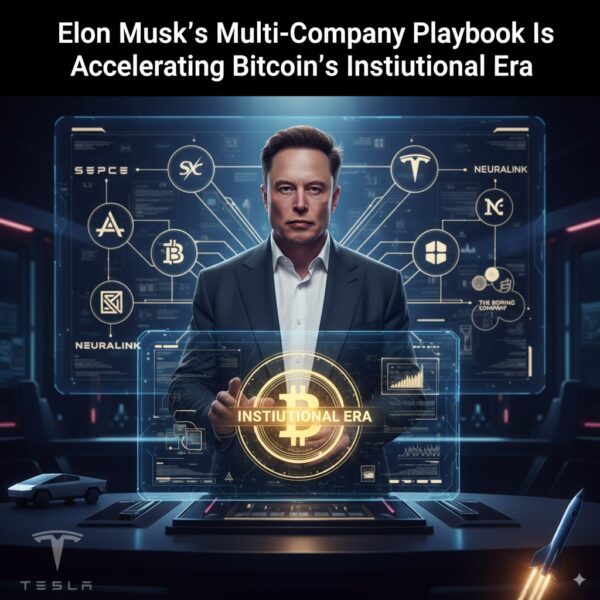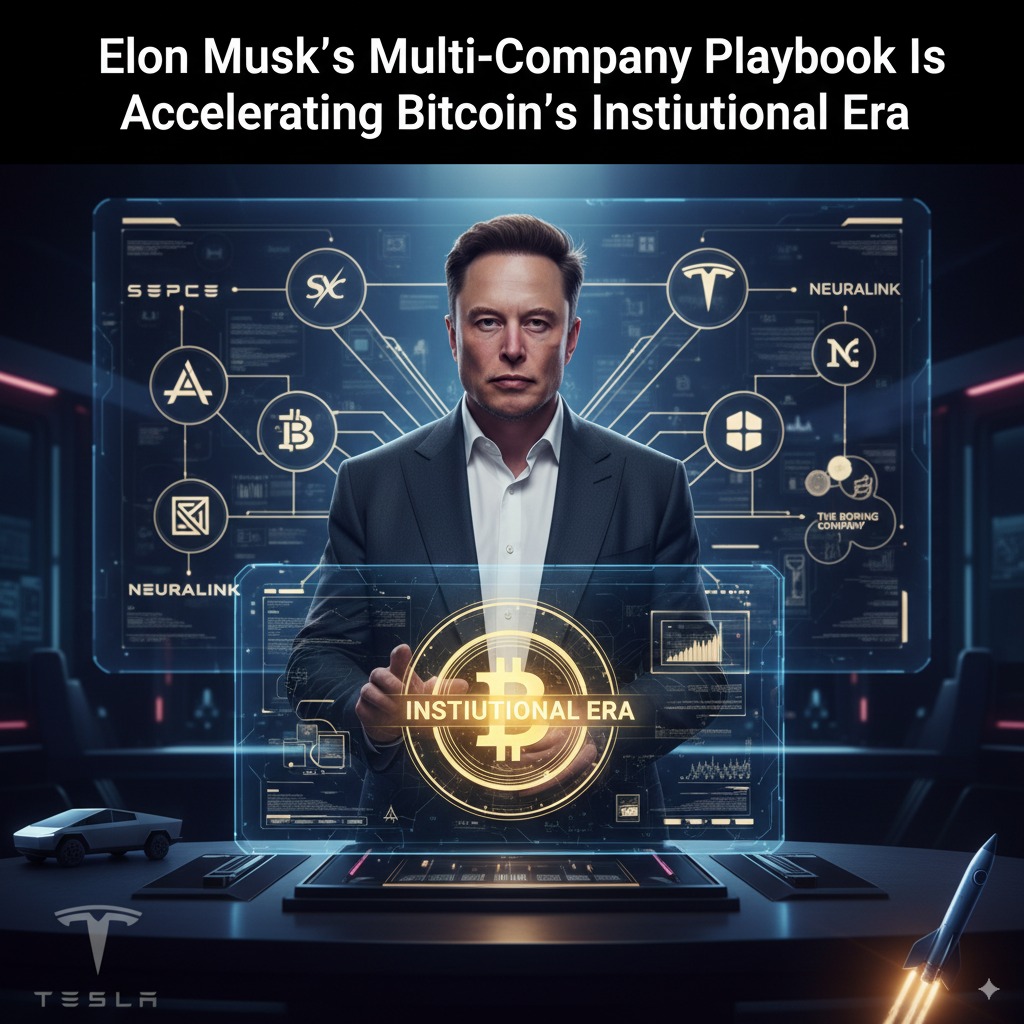Elon Musk’s Multi-Company Playbook Is Accelerating Bitcoin’s Institutional Era
0
0

BitcoinWorld

Elon Musk’s Multi-Company Playbook Is Accelerating Bitcoin’s Institutional Era
Elon Musk’s influence on digital assets has evolved beyond market-moving tweets into a structured, multi-company strategy. Through Tesla’s Bitcoin exposure, SpaceX/Starlink’s cash-flow inflection, xAI’s compute ambitions, and X’s steady march toward licensed payments, Musk sits at the center of a feedback loop that’s helping normalize Bitcoin for institutions—right as U.S. spot Bitcoin ETFs consolidate trillions in liquidity across regulated rails.
Key Takeaways
-
Tesla remains a top corporate holder of Bitcoin, with ~11,509 BTC reported by industry trackers and covered by mainstream crypto media, making its quarterly results a bellwether for corporates with crypto exposure. CoinDeskBitcoin Treasuries
-
SpaceX has emerged as a significant BTC treasurer, with blockchain-intelligence estimates around 8,28x BTC in 2025—a sign that blue-chip private tech firms are also engaging Bitcoin at treasury scale. ArkhamBitbo
-
U.S. spot Bitcoin ETFs (led by BlackRock’s IBIT) have cemented institutional access; IBIT alone shows ~$81B in assets as of Aug. 29, 2025, making ETF flows a primary driver of liquidity and price discovery during U.S. hours. BlackRock
-
X (formerly Twitter) continues to add state money-transmitter licenses and registrations needed for U.S. payments—incremental plumbing that could plug hundreds of millions of users into on-platform value transfer over time. NYSenate.govPayments Dive
-
xAI is scaling compute aggressively, open-sourcing Grok 2.5 and outlining targets equal to tens of millions of “H100-equivalent” GPUs over five years—positioning Musk’s AI stack close to real-time markets, payments, and user intent. Tom’s Hardware
The Institutional Backdrop: From Tweets to Term Sheets
The turning point for Bitcoin’s mainstream adoption in the U.S. was the arrival of spot Bitcoin ETFs in 2024, which turned complex custody into a ticker symbol. By August 2025, BlackRock’s iShares Bitcoin Trust (IBIT) alone reported ~$81B in net assets; sector-wide flows now routinely swing prices during U.S. sessions as wealth managers and institutions allocate or de-risk via regulated wrappers. BlackRock
That structural shift matters for Elon Musk. A deeper institutional base reduces the marginal impact of celebrity commentary while increasing the financial statement salience of corporate Bitcoin holders—especially now that FASB fair-value rules let companies mark BTC gains and losses each quarter. For Tesla, that can make crypto marks a visible offset—or amplifier—to cyclical automotive swings. CoinDesk
Tesla: BTC on the Balance Sheet, Visibility in the Footnotes
Tesla remains one of the world’s best-known corporate holders of Bitcoin, sitting around 11,509 BTC per industry trackers like BitcoinTreasuries and reporting coverage by CoinDesk in Q2 2025. While Tesla sold a large portion of its original 2021 buy during 2022, the company has since maintained a significant position that rose in reported fair value alongside BTC’s mid-2025 rally. Bitcoin TreasuriesCoinDesk
In Q2 2025, Tesla’s shareholder materials highlighted the company’s broader financials and strategic transition, but the newfound accounting treatment made Bitcoin’s quarterly mark-to-market more visible to analysts parsing the results. For investors, that means Tesla’s crypto exposure isn’t just a one-off headline; it’s a line item that can swing reported earnings in volatile quarters. Tesla
SpaceX/Starlink: Cash Engines—and a Quiet BTC Signal
While SpaceX is primarily a launch and satellite-internet business, blockchain-intelligence dashboards tracking corporate wallets estimate ~8.28k BTC under the SpaceX umbrella in 2025, fluctuating with treasury moves and market prices. The signal: even private mega-cap tech firms with heavy capex cycles are comfortable holding a non-trivial amount of Bitcoin. That aligns with Starlink’s improving unit economics and rising subscriber base—additional ballast behind treasury experimentation. ArkhamNext Big Future
Musk also projected ~$15.5B in 2025 revenue at SpaceX earlier this year—signaling scale that few private tech companies can match, and a financial base from which to explore alternative treasury strategies, including Bitcoin. Reuters
X Payments: Building the Pipes (and the Moat)
X has steadily pursued state-by-state money-transmitter approvals, plus FinCEN registration—requirements for peer-to-peer payments and, eventually, interoperability with broader financial rails. Public documents and trade coverage show X holding licenses or approvals across ~40+ states and D.C., though New York remained a gap as of May. The practical meaning: X is laying regulatory plumbing that could, over time, support wallet features, tipping, merchant flows and (where permitted) crypto-adjacent integrations—all within a real-time, social context. NYSenate.govPayments Dive
Such rails don’t guarantee crypto features, but they do position X to direct user attention and orderflow—especially relevant if ETFs and broker integrations normalize BTC exposure for mainstream users.
xAI: Compute at the Edge of Markets
If Bitcoin is the asset, xAI is the sensor layer. Musk has repeatedly stressed the need for orders-of-magnitude more compute to train frontier models. Recent statements emphasized targets equal to 50 million H100-equivalent GPUs in five years and open-sourcing strides like Grok 2.5—a posture that puts xAI in the same league of ambition as OpenAI or Meta and inches Grok closer to live, finance-relevant reasoning. Tom’s Hardware
As the ETF rails industrialize BTC exposure and X iterates payment plumbing, a Musk-stack of real-time conversation (X), real-time inference (xAI), hard-asset treasuries (Tesla/SpaceX), and global connectivity (Starlink) forms a uniquely integrated platform touching both user demand and capital allocation.
Risk & Regulation: The Parts Still in Motion
A broader institutional footprint does not eliminate risk. ETF flow concentration can amplify day-to-day volatility and create reflexive feedback loops between asset prices and fund subscriptions/redemptions. Corporations face earnings volatility under fair-value accounting, and payments platforms must navigate multi-jurisdictional licensing with uneven timelines. Meanwhile, Musk’s ventures themselves face legal and competitive pressures, including recent xAI trade-secret litigation, underscoring how intense the AI and data race has become. BlackRockNYSenate.govReuters
What It Means for Investors Watching Elon Musk
-
BTC as a balance-sheet variable: For Tesla (public) and SpaceX (private), BTC can diversify cash but introduces mark-to-market swings—relevant for equity analysts and private-market investors alike. CoinDesk
-
ETF rails = mainstream on-ramps: IBIT’s scale shows the preferred path for advisers and institutions is regulated, custodied exposure—not exchange accounts. That supports liquidity, tighter spreads, and consistent demand shocks from advisory models. BlackRock
-
Regulatory compounding: Each new X license compounds optionality for payments. If wallets and value transfer become native at scale, attention and transactions converge—fertile ground for integrated financial features. NYSenate.govPayments Dive
-
AI + markets: xAI’s open-source moves and compute plans hint at faster product cycles around finance-aware assistants. If Grok becomes reliably real-time on market data, it could reshape discovery, research, and even compliance interfaces. Tom’s Hardware
Data Points: Elon Musk and Bitcoin in 2025
-
Tesla BTC: ~11,509 BTC (industry trackers), with fair-value marks now visible in quarterly reporting coverage. Bitcoin TreasuriesCoinDesk
-
SpaceX BTC: ~8.28k BTC (Arkham-linked analysis), fluctuating with treasury activity. Arkham
-
ETF Scale: IBIT ~$81B AUM (Aug. 29, 2025), anchoring institutional access. BlackRock
-
SpaceX 2025 revenue guide: ~$15.5B (Musk), reflecting scale that can underpin more flexible treasury management. Reuters
The Bottom Line
Elon Musk no longer influences Bitcoin solely through sentiment. In 2025, his companies’ balance sheets, product roadmaps, regulatory filings, and AI infrastructure interact with the maturing ETF ecosystem to institutionalize Bitcoin exposure. Whether Bitcoin continues higher or whipsaws, the rails are now built: regulated funds move billions daily; corporates can mark assets to market; and social-payments infrastructure is approaching critical mass. That interplay—more than any single quip—defines Musk’s role in Bitcoin’s next institutional chapter. BlackRockCoinDeskNYSenate.gov
This post Elon Musk’s Multi-Company Playbook Is Accelerating Bitcoin’s Institutional Era first appeared on BitcoinWorld and is written by Editorial Team
0
0
 Manage all your crypto, NFT and DeFi from one place
Manage all your crypto, NFT and DeFi from one placeSecurely connect the portfolio you’re using to start.





